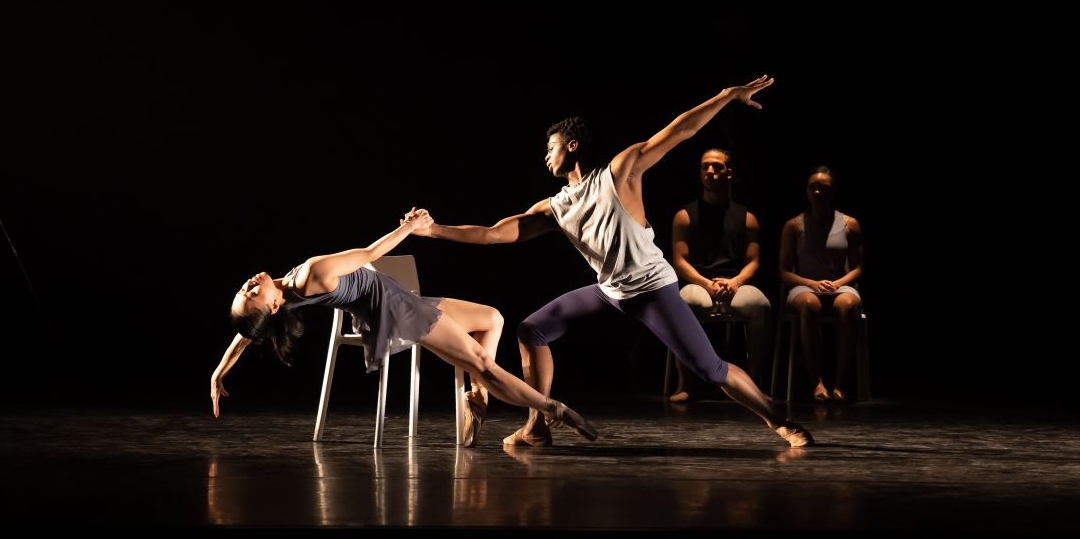This fresh double-bill from Ballet Black introduces two works – ‘Then or Now’, which had a very brief outing ahead of the pandemic, and ‘Nina: By Whatever Means’, a new piece focused on the life and music of Nina Simone. Each of them speaks to two of the continuing priorities of this fine company, which celebrates its 21st season this year. The first demonstrates the full gamut of classical dance technique, presented by black artists of the highest calibre claiming their rightful place at the heart of the genre. While the second is a celebration of a central figure in twentieth-century black culture who suffered a great deal for her art and engaged fiercely with the political struggles of her day.
In ‘Then or Now’, choreographer Will Tuckett creates a complex set of relationships between movement, music and text. The musical backcloth is provided by a mesmeric passacaglia for solo violin by the seventeenth-century composer Heinrich von Biber, together with variations upon it by the player Daniel Pioro. The next layer is provided by three voices intoning poems by Adrienne Rich from her 1995 collection ‘The Dark Fields of the Republic’ which emphasise the different forms love can take and how the personal is almost always – at some level – political. A final overlay is provided the eight dancers, four male and four female, all dressed in monochrome. A scatter of chairs completes the staging.
From these foundations emerges a complex collage of gestures and emotions within which the audience is a participant, with each of us given space to reflect on the relationships between the different elements. Sometimes the balletic gestures are mimetic, imitating the drift of the words directly; but in other respects the expressive language is only gradually made clear as fragmentary sequences of studied and poised elegance are gradually assembled and worked through. There are episodes for single dancers, couples and the full ensemble and the whole gathers confidence and pace as the passacaglia itself takes over in the final minutes. The deliberate almost improvised abstraction of the piece both witholds definition and also gives us time to identify our own meaningful resolution, just as Rich’s verse avoids dogmatism, but gives hope that individual and collective efforts can always make a difference in testing times.
In contrast, there is almost too much narrative to work with in ‘By Whatever Means’. After an opening nod to her edgy performance at the 1976 Montreux Jazz Festival, choreographer Mthuthuzeli November takes Simone through her childhood experiences, whether playing piano in church, practising with an exacting teacher, or working in jazz clubs, in a series of short, somewhat breathless scenes that attempt to do too much. But then the pace settles and in two majestic sequences set to Simone’s versions of ‘Mood Indigo’ and ‘Sinnerman’ we find the real justification for a balletic treatment of Simone’s life. Just as she famously found new meaning and resonances in other people’s songs, so here the dancers, led by an impressive Isabela Coracy as the adult Simone, find and then radiate outwards the imperious intensity, courage and anger that distinguishes this artist’s best work. Here the dance provides critical added value.
A disturbing interlude depicts Simone’s abusive marriage to Andrew Stroud. Both Coracy and Alexander Fadayiro play this scene with great skill as intimacy tips over into jealousy and violence, ably depicted in the shifting moods of the choreography, and despite their having to negotiate an errant carpet. The culmination of the sequence takes us into Simone’s commitment to the campaigns of the Civil Rights Movement. Here Coracy’s defiant self-assertion is joined by the rest of the cast, now in hooded garments, affirming both their solidarity with her and celebrating the collective efforts of the era. This proved a rousing conclusion to the evening and a fine embodiment of what Simone stood for and what she sacrificed along the way.
As always with this company, bravura technique combines with a strong political commitment to represent dance, whether classical or modern, as urgent and central to our conerns rather than decorative or merely entertaining.

